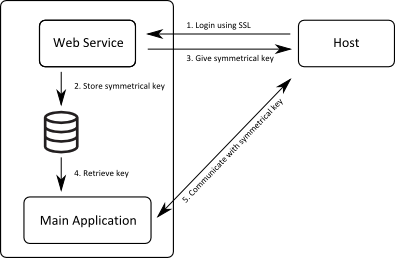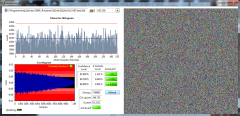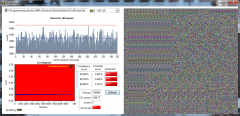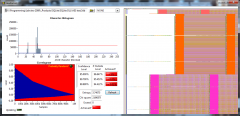Search the Community
Showing results for tags 'encryption'.
-
Does any one have an idea on how to password encrypt an Excel file (or csv) in LabVIEW or zip up the excel file/csv and add a password to it that way? I need to be able to add a simple encryption to confidential patient data files after they are created and be able open them to read later by the same program. I've tried using OpenG to add a password protection to a Zip file but when I try to add a string variable to the password connector it says password (none) so it makes me feel like I'm doing this wrong. I couldn't really find any similar documentation or tutorials on creating a csv or excel file then zipping up the file and adding a password to the zip with OpenG though I read about the function on the Labview forums. A few other things over I've tried recently: I think a solution would be to use some sort of property/ invoke node with ActiveX like I've attempted to do in the picture below but I can't find anything that explains exactly how property and invoke nodes work with ActiveX to achieve what I wanted, and I was hoping someone would have a tutorial that a LabVIEW beginner like me could use. Something else that I looked at was adding a "blowfish" encryption to encrypt the data but seemed extremely complicated and all I need is a simple password encryption. Finally I tried using an add on called AES crypto but I felt that the encryption methods that were featured in the add on were limiting. For patient names they would be at different lengths and in the example programs it showed that if a string was shorter than 128 bits then it would't be able to encrypt the string. Which is an issue if the patient has even a regular length name. If you have any thoughts or find anything useful let me know. Thanks, From a beginner usmanf
- 2 replies
-
- labview
- encryption
-
(and 2 more)
Tagged with:
-
Hello everybody! During a few last years I received multiple appeals to release AES library that I developed in 2011 into open-source. So, I've just done exactly this: https://github.com/IgorTitov/LabVIEW-Advanced-Encryption-Standard I released it under MIT license (which means that there are no restrictions whatsoever). No VI passwords, no uglification. LabVIEWishly Yours, Igor Titov.
- 7 replies
-
- 13
-

-
- aes
- encryption
-
(and 2 more)
Tagged with:
-
ShaunR's recent topic on Security reminded me of a situation we explored in the summer and need to revisit at some point. We were looking for a method to protect the communication with a cRIO. The situation is that we need to communicate between a cRIO and a host on an unsecured network (manufacturing environment.) We concluded that we needed some form of encryption as well as a standard login mechanism but identified that having a single symmetrical key would not provide enough protection (for various reasons and specific use cases.) Therefore, we looked into SSL and LabVIEW Web Services because it already includes that library and all the security features that we need. We figured out that it would definitely offer the protection required but that would mean rewriting most of existing code to use Web Service instead or establish some for of communication through a new Web Service. Considering the amount of unknown and risks associated with modifying our code, we looked into an alternative and came up with the following scheme: In short, we would use a Web Service for the initial login and create a new symmetrical key which would be passed to the host and to the main application on the target (cRIO) and would be used to encrypt/decrypt all data during the session. This way, we could still program all of our code in LabVIEW and easily download/deploy the services and applications to the Target using NI standard tools but benefit from proper security and only have to add fairly simple wrappers to some sections of our existing code. I wonder if anyone else has already gone down that route to add protection to an existing application. Would you suggest a different implementation method or an easier path to a similar result? Is there some obvious pitfalls in this approach that we do not see?
- 2 replies
-
- 1
-

-
- encryption
- web services
-
(and 2 more)
Tagged with:
-
Hi, One of my customer is creating systems with high added value. These systems relies on a both CompactRIOs and deported computer code. These systems will be deployed all around the world, and should be hardly protected against copy. Concerning the computer code, they decided to use a dongle system to decrypt the exe each time this one is launched. How to do something similar with the RTEXE on a compactRIO ? Is there a solution to encrypt an RTEXE ? Is it possible to remove VI's block diagrams in a RT EXE ? Is this solution sufficient to protect the code from reverse engineering ? Any advice will be welcomed ! Thanks !
- 4 replies
-
- protection
- encryption
-
(and 1 more)
Tagged with:
-
From the album: ShaunR
SQLite database statistical analysis with AES 256 CBC encryption. N.B. 1. Multiple encoding runs produce new database byte-map. - differential analysis resistant. 2. Statistically indistinguishable from random data. - statistical analysis resistant. -
From the album: ShaunR
SQLite database statistical analysis with AES 128 ECB encryption. N.B. 1. Multiple encoding runs produce identical database byte-map - susceptible to differential analysis. 2. Information leakage and correlation especially for zero values - susceptible to statistical analysis.. -
From the album: ShaunR
SQLite database statistical analysis without encryption-
- none
- encryption
-
(and 1 more)
Tagged with:








